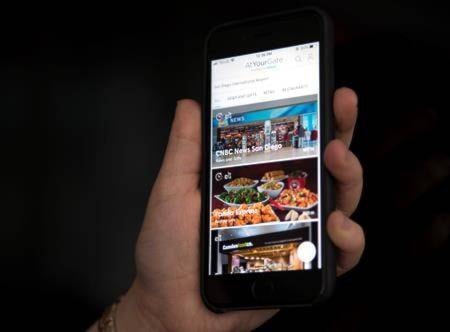TORONTO — P.J. Mastracchio is used to dashing through airports only to arrive at his gate and have a terrible feeling start to sink in: hunger pangs.
The frequent business traveller’s routine rush often leaves him with no time to grab a bite. Now, he’s betting his experience is so common it will help get his recently-launched airport delivery service AtYourGate off the ground.
The delivery service, powered by Montreal-based mobile platform GOLO, allows travellers to place orders from restaurants or convenience stores in the airport through the AtYourGate app. The items get delivered to the passenger’s gate, cutting out the need to wait in line for food or walk far distances through the airport to fulfil cravings. For those tight on time, orders can be scheduled in advance to arrive just as you board or deplane.
So far AtYourGate is only available at San Diego International Airport, but it has lofty ambitions to roll out across Canada as it tries to tackle what could be the next frontier for delivery apps: airports.
AtYourGate faces competition from app-based food delivery pioneer Uber Eats, as well as smaller startups and even airports themselves.
Uber Eats Canadian general manager Dan Park said it is experiencing an increase in orders made to airports, though the company can’t make deliveries past security yet. Airport Sherpa launched at Baltimore/Washington International Airport in July. And a spokesperson for the Edmonton International Airport said it hopes to launch a similar offering and the Halifax International Airport Authority said it has explored such a service, but doesn’t have anything in the works.
The idea of delivery services at airports is growing in popularity and something travellers could find very useful, said David Soberman, a University of Toronto marketing professor.
“(Airports) are crowded, often the stores aren’t where your gate is, and it can be challenging, especially if you are a family travelling with kids or if you are an older person. There are all kinds of people that would find this convenient,” he said.
When it launched in January, AtYourGate was only available for airline employees — ticket agents, runway and baggage crews — that often can’t find time to stop for food or are too far from airport restaurants. Southwest Airlines has allowed AtYourGate on board planes to make deliveries to flight attendants that don’t deplane during very short stopovers.
Within two months, Mastracchio said it expanded to include passengers and has since seen sales growing by 20 per cent per week on average.
“We see passengers arrive at their gate, sit down, look around and realize there is not much there, so they open the app and order. We even got an order at 3:11 a.m. the other day for an 8 a.m. Chinese food delivery,” said Mastracchio, AtYourGate’s chief executive officer.
“Saturday night we served 20 teenagers, 13- and 14-year-old boys, flying back to Boston from Spring Break with their chaperone. The guy bought 20 meals and was thrilled and the kids were thrilled. Those are things we are finding every day at the airport.”
AtYourGate charges customers $2.99 at every vendor they order from, which is divided between the company and the airport.
GOLO chief executive office Jean-Francois Noel hopes it will be a formula that can be replicated beyond San Diego. He said AtYourGate is contacting all major airports in Canada about the app and is hopeful that by the end of the year it will have lured at least one major airport in the country to launch the service.
“We are also in discussions to bring this concept into office towers hospitals and universities,” he said. “Everywhere you have a building, merchants and users you can create an e-commerce based community.”
The potential to turn any gathering space into a food-delivery opportunity is a page out of Uber’s playbook. In Canada, the company has seen deliveries to plenty of unconventional spaces including airports, sports centres, hotels, beaches, parks and cultural landmarks.
Park said thousands of orders have made their way to Canadian hospitals, including St. Michael’s, Mount Sinai and the Women’s College Hospital, all in Toronto. The app even allows users to drop a pin for delivery at a park bench or a swingset, where there isn’t an address, so parents and hungry kids enrolled in sports or engrossed in the playground can be fed conveniently.
Park said colleges and university communities have also proved to be “fantastic” for Uber Eats.
“When you see those things in those kinds of markets, it starts opening up opportunities,” he said, adding that it is also looking into partnerships with schools and for meal plans.
When it comes to unconventional spaces, he said business travellers are “probably the biggest use case,” given that hundreds of Uber Eats orders are coming every month from airports.
The orders typically get delivered to passenger dropoff spots, long before travellers reach the airport’s security checks.
Liquids can be hard to get past the checks, but Park said dishes that tend to be popular with Uber Eats users in general — sandwiches, burgers and noodles — don’t prove as challenging.
When asked whether Uber Eats will start delivering straight to gates, Park said, “It’s always a possibility.”
He stressed that for now the company is focused on ease of ordering, speed and reliability, but added, “When you create that magical, unexpected experience for customers, the number of use cases that come up are somewhat infinite.”
Tara Deschamps, The Canadian Press
